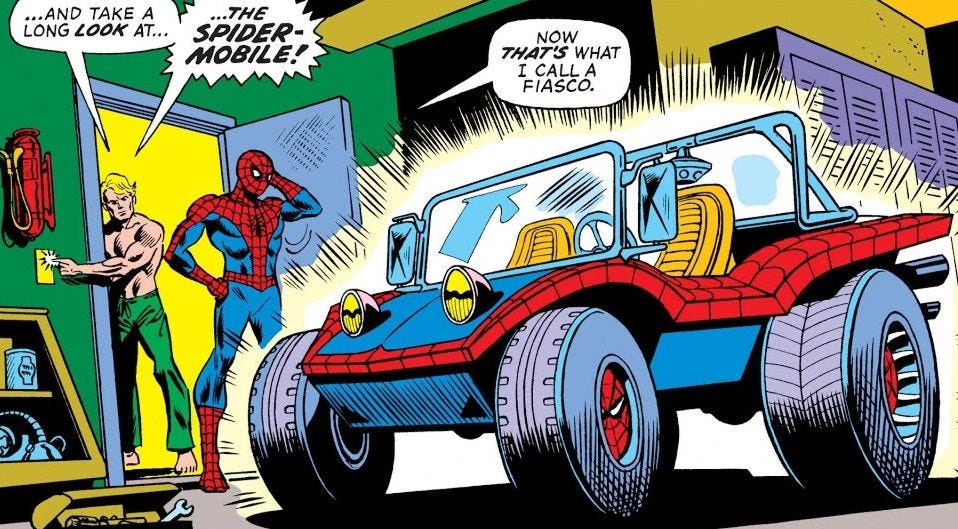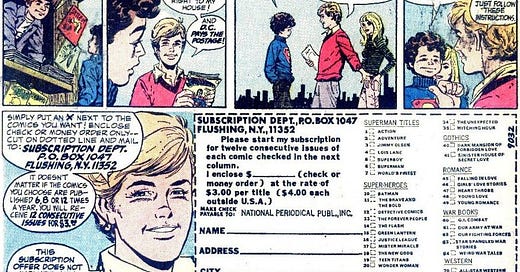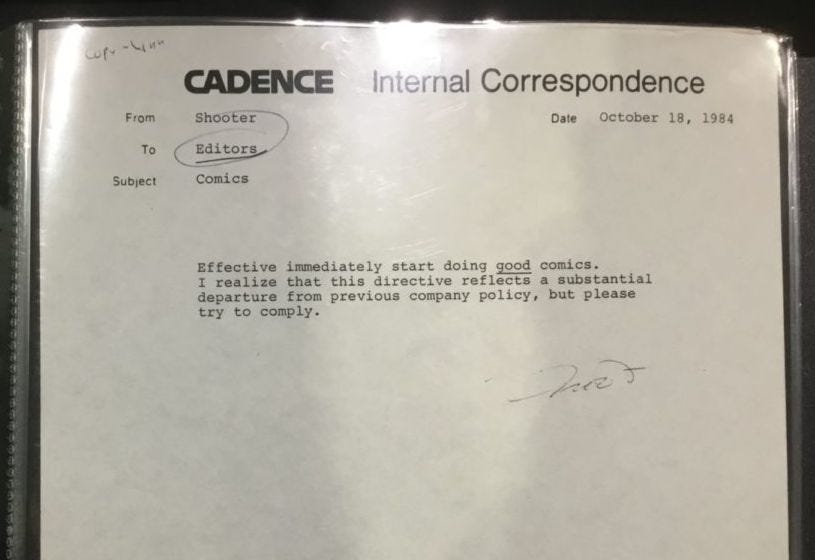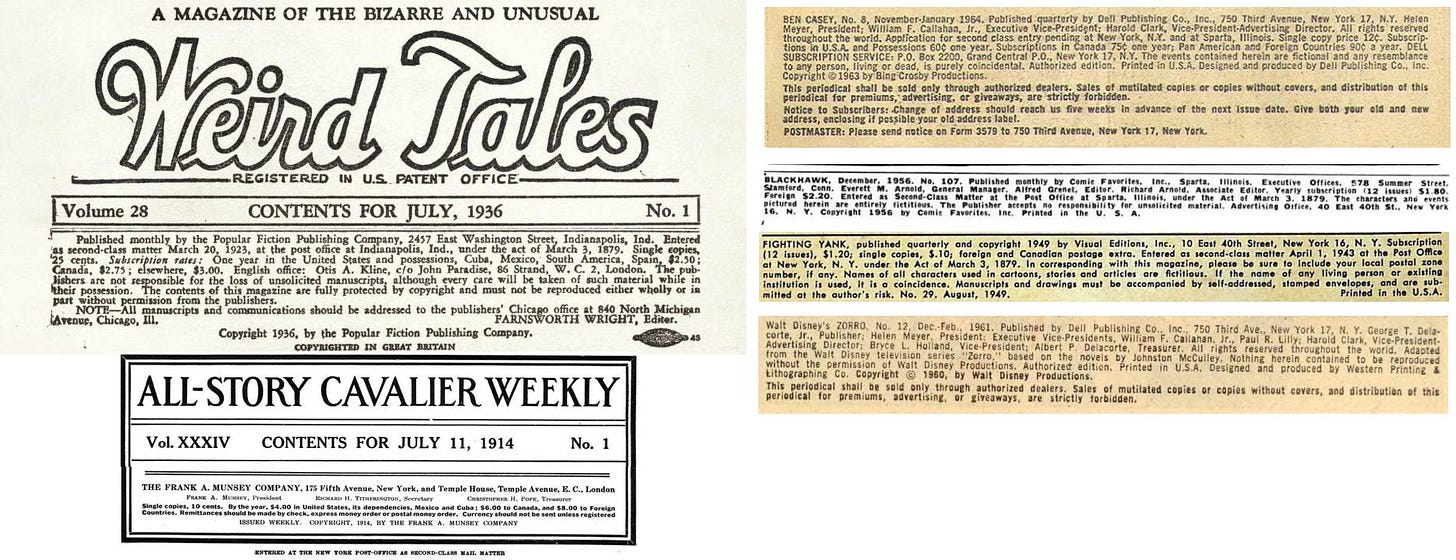Comic Book Distribution & Putting a Stop to ‘Characters Writing Themselves’
The Mechanics of Comic Book Sales & Disrupting the Character History You Laid Down for the Purposes of Filthy Lucre and Spider-Mobiles
POSTS IN THE SERIES: Post 1 Post 2 Post 3 Post 4 Post 5 Post 6
Note 1: I am currently working on one or more posts discussing the American comics codes and their effects on publishing, as well as the furor(s) that surrounded them. Life has once again intruded these last few weeks, but with luck, sometime next week you should see the first one posted. In the meantime, I am reposting a series of six articles that I wrote about two and one-half years ago on American comic book history. I might make a few corrections along the way. We’ll see.
Note 2: I do not strive to be either academically rigorous nor authoritative in my analysis, and I’m an opinionated cuss. Other authors have spent a great deal of time interviewing the principle actors and performing rigorous historical research, therefore I lean heavily on those individuals who did the heavy lifting on this topic. My posts are meant to review some results of these researchers’ data and findings, as well as examining other artifacts of comic book history, to attempt to find general or overarching patterns that may inform and guide current and future creators of comics. References to the sources I use will be provided at the bottom of this and future blog posts.
Note 3: Some of these posts are gonna blow up your e-mail. Sorry ‘bout that.
THE COMIC BOOK DISTRIBUTION STORY: HIGHLIGHTS AND LOWLIFES
After spending over three days reading, re-reading, and making notes, it has become clear to me that Jim Shooter’s articles on distribution really can’t be effectively summarized. His three-post series is a concise and complete story of his experiences with the Newsstand Model, the creation of the Direct Market model, the transition from the dual model to Direct-only Distribution, and the implications thereof.
Jim’s personal experience with the Newsstand and Direct Market systems are likely unique in the industry due to the positions he held. I strongly recommend reading these three articles. Twice. Though his blog is not active, it has many such nuggets of information on comic books and history that may interest you.
While Jim Shooter’s summary will give you what you need to know about comic distribution, if you wish more detail on distribution, and the perspective of a local comic store dealer, as well as a dealer with national reach, then you should tackle Chuck Rozanski’s Mile High Comics blog, Tales from the Database.
Almost 40 articles detail Rozanski’s distribution experiences and his discussions with major players from the comic companies, newsstand distributors, and direct market distributors. As with Shooter’s blog, there is a wealth of information in these articles on distribution and on other comic book history. To summarize Rozanski’s articles would be to duplicate Jim Shooter’s blog posts, so I will not attempt it.
Begin your reading here:
… and read through to here:
Shooter’s and Rozanski’s analyses are well worth your consideration. A point that both Shooter and Rozanski make is that both distribution models have their advantages and disadvantages. Shooter points out that the market would probably be stronger if both models survived and were used together, and he attempted to move that direction within the company. He didn’t succeed in that effort. Shooter was fired from Marvel in 1987. The single Direct Market model moved forward at Marvel after his departure.
Both men also point out the Newsstand model was where most new readers originated, and that the loss of the Newsstand market made expanding the comics market difficult. Movies, television, and other IP development keeps the name of your product on the public’s lips, but that often doesn’t translate to selling your magazines.
There is good information here to keep you busy reading and pondering for some time.
Jim Shooter also catches a fair deal of undeserved flack from haters. Here’s a booster shot of factual data from someone who did a deeper dive on Shooter’s past than most do:
Was Shooter a “sigma”? I think so.
Here are other artifacts from the bygone days. How could you bypass all this goop with distributors and retailers and comic shops? Why, go direct to the source, of course. Subscriptions via US Mail. If you looked at a comic book, or a Pulp Magazine from the Newsstand era, this is what you’d typically find at the bottom of the inside cover or the bottom of the first page of a typical comic book.
That’s right. Pitch the company a few bucks a year, and you get your pulps or comics delivered at 2nd Class / Periodical Rate directly to your mailbox. And DC made it even easier in the 70s with a punch list.
But this didn’t last much longer than the Newsstand distributor model for most companies. DC dropped their subscription services in 1999 — at the behest of LCS owners.
WHAT WAS CONSIDERED FOR NEW TITLES AFTER THE 1968 SALE?
Browsing Chris Tolworthy’s site, and from reading other comic book blogs talking about the late 60s/early 70s era, it was clear that Stan, Jack, and the rest of the Bullpen were convinced that superheroes were a fad that would run its course, as it did in the WWII era. In fact, they were concerned that in 1968 it already HAD run its course.
Action for Children’s Television had put the kibosh on action-themed cartoons following the assassinations of Robert F. Kennedy and Martin Luther King, citing Hanna-Barbera’s Birdman as a prime offender, concerned that violent cartoons would make for violent children. That meant that future Fantastic Four and Spider-Man cartoons would be more difficult to produce. Sales were already beginning to fall off across the board in Marvel titles after the 1968 expansion of its line. The company began to look at other genres for the Marvel Comics stable.
These are some, not all, of the new comics starts from 1968 through 1983.
Note how during 1969 through 1973 the typical new starts were an admixture of Horror/Monster, Adventure, SF, Fantasy, Romance, War genres, with few Superhero titles introduced. Movie property adaptations were added to that mix in the mid-70s along with Kirby’s 2001 and Eternals lines. Superhero new starts finally came back to prominence after 1978 (the Jim Shooter era).
Marvel was testing the waters during the downturn years after 1968. Note all the titles they harvested from 1950s Atlas and 1960s Marvel.
After the 1968 sale, Marvel never found their footing on solid ground except in the Superhero genre and some Movie/Entertainment property adaptations.
WHY I HEAVILY CURATE THE COMICS IN MY COLLECTION: A RANT
A point made by Chris Tolworthy in his discussion of the Marvel sale in 1968 was that the rule of ‘Realism’ (what I claim is ‘Verisimilitude’) used at Marvel prior to the sale was replaced with the ‘illusion of change’. Stan’s pre-1968 method was, as he described to “let the characters write themselves”. But, a successful Hanna-Barbera Fantastic Four cartoon and independent Spider-Man cartoon, branded t-shirts and sweatshirts, and ‘Merry Marvel Marching Society’ kits had opened the potential for merchandising Marvel characters. There were now monetary reasons not to let characters radically change, or to change at all, so as not to rock the boat that had set sail to Treasure Island.
Let’s take a look at Spider-Man, both before and after the approximate sale date of April 1968. This would correspond to Issue 59. As I saw it, Lee and Ditko relied on the action of Spider-Man to balance with the interpersonal interactions in the book, but Lee and Romita leaned more on their romance comics background and brought the interplay of the characters to the fore in almost a competition with the action of Peter’s costumed alter-ego. Both these brands of storytelling were very popular with the Spider-Man readership.
Thus, we need to look at the supporting characters more than the villains Spidey battled for the Lee/Romita years. For some background, Aunt May, Uncle Ben, Flash Thompson, and Liz Allan were introduced in Spider-Man’s origin story in Amazing Fantasy Issue 15. J. Jonah Jameson first appeared in Amazing Spider-Man Issue 1, and Betty Brant in Issue 4. Frederick Foswell first appeared in Issue 10, Anna Watson (Mary Jane’s aunt and the Parker’s neighbor) was introduced in Issue 15, and Ned Leeds appeared in Issue 18. Harry Osborn, Gwen Stacy, and Professor Warren were introduced into the continuity in Issue 31 by Lee and Ditko as Peter started college. Norman Osborn was introduced in Issue 37, one issue before Ditko’s departure from the book. Mary Jane Watson had been partially revealed in Issue 25, but made her full appearance under John Romita in Issue 42.
Lee and Romita’s first two books (Issues 39 and 40) were the confrontation between the Green Goblin and Spider-Man, revealing Norman Osborn as the Goblin, and Osborn discovering Peter’s identity as Spider-Man. Osborn was hurt during the battle and developed amnesia regarding the Goblin and Spider-Man, to include his identity. Peter disposed of the Goblin outfit and devices in the fire that had started. The book took on a very romance comic undertone that permeated the story from that point, though it retained the superhero facade.
Between Issue 42 and Issue 59, Peter gravitates to Gwen Stacy vice Mary Jane Watson as his steady girlfriend, though Mary Jane is continually competing for Peter’s attention. Flash Thompson joins the Army and becomes a war hero in Vietnam. Peter and Harry become roommates while at college. Ned and Betty marry and become Daily Bugle fixtures. Foswell dies in a gun battle while saving JJJ from the Kingpin’s thugs.
Robbie Robertson was introduced in Issue 51, and became a buffer between Peter and Jameson, ensuring that Peter received appropriate reimbursement and recognition for his photos. Robbie also was very observant and noted immediately that Peter was hiding some sort of secret. The additional pay Peter was now receiving allowed him to send Aunt May on rest and recuperation trips, accompanied by Anna Watson.
In Issue 56, Gwen’s father, retired police Captain George Stacy made his first appearance. Stacy, being a retired police officer, was immediately clued that Peter was hiding something, just as Robbie Robertson was. (That Capt Stacy had surmised Peter was Spider-Man was confirmed in Issue 90.)
This all sounds reasonable as far as character development and evolution in the series up to Issue 59. So what is the problem?
Consider Spider-Man’s story evolution in the series, as guided by Lee/Ditko and Lee/Romita. The evolution was slower under Lee/Ditko, but change transitioned into high gear under Lee/Romita. Regardless of speed, Peter and the cast of supporting characters evolved and grew over the course of the series. Let’s compare Spider-Man 1 through 8 to Spider-Man 52 through 59.
Look at how Spider-Man began in those first eight issues with the status of Peter Parker. Peter was (1) a single high-school student, (2) a bit of a loner, (3) without a girlfriend, (4) was the primary caretaker for his widowed aunt, (5) a crimefighter, (6) a freelance photographer covering crime, (7) poor and had difficulty making money.
As of issue 59, four-and-one-half real-world years later, Peter was (1) a single college student, (2) well-liked by many, and old rivals were becoming friends, (3) dating his steady girlfriend (Gwen) with other women chasing him (Mary Jane), (4) grateful that Aunt May had a friend who served as a part-time caretaker (Anna Watson), (5) a crimefighter with a strong reputation, (6) a better-known freelance photographer covering crime, (7) not-quite as poor and with better prospects due to college and better boss at the Bugle, AND (8) fortunate to have two father-figure mentors who were available to advise him (Robbie Robertson and Capt George Stacy).
If we let Stan’s concept of “let the characters write themselves” that was used prior to April 1968 play out, what should develop in this evolving situation that is outlined above?
PETER PARKER PROPOSES TO GWEN STACY, SHE ACCEPTS, AND THEY MARRY.
For the Suits at Marvel who are staring at the gold mine of merchandising and IP development, this likely appeared to be a disaster.
Why?
That would have created an exceptionally stable family environment for Peter (husband, wife, father-in-law, aunt, aunt’s caretaker/friend, friend of family–Mary Jane). It would also create a much more stable job environment for Peter at the Bugle, where one of Peter’s bosses (Robbie) knew why he acted as he did and how he obtained his photos. Despite it being part-time employment due to his college studies, Peter’s overall stress would likely be reduced due to greater stability in both his home and his job. Peter would move from swingin’ single to happily married hubby with kids on the way.
“HOW’S THAT GONNA PLAY WITH THE COLLEGE CROWD?!”
If Stan had been given direction to maintain the “illusion of change”, then the story line he and John Romita were crafting prior to April 1968 could not continue as it was. Stan’s own advice to “let the characters write themselves” couldn’t continue to direct the plotting, as it would make-over the currently popular character into a family man with responsibilities.
“HOW DULL AND BORING!”, SCREAM THE COLLEGE BOOMERS.
After Issue 87 (August 1970), that direction began to change. In three more issues, Capt Stacy would be dead. In ten more issues, Harry Osborn would be a drug addict. In thirteen issues, Spider-Man would have six arms and fight a vampire. More of the same occurs in subsequent issues: Trip to the Hidden Land with JJJ and Gwen while fighting Kraven with Ka-Zar. Flash Thompson, war hero, kidnapped by strange Vietnamese monks who want him dead. Spider-Man battling the Hulk in Canada, because – reasons! Norman Osborn gets his memory back, kills Gwen Stacy, then dies in battle with Spider-Man. Harry Osborn becomes the Goblin, discovers Peter’s identity, and takes over where Dad left off. Professor Warren gets lonely at college, clones Gwen and other cast members, dresses up in a Jackal outfit, and starts the first Clone Saga. The Spider-Mobile.
Oh, the Spider-Mobile.

Things got “superhero crazy” starting in Issue 88, then they went off the rails by the time issue 150 showed up to play.
So, again, what did we get in trade for Captain Stacy and Gwen Stacy’s deaths?
Six-armed, vampire-fighting Spidey
Crazy Harry Osborn, the Drug Addict Green Goblin Junior with Dead-Dad Anger Issues
Wild-and-crazy Mary Jane Watson, as a fast drop-in replacement for stable wife-material Gwen Stacy
The first Clone Saga with Loony Lovesick Professor Miles “Jackal” Warren, and
The Spider-Mobile.
Woo!
Half of Peter’s normal supporting cast is carved away in a bloody swath, leaving him really not much affected at all by the events, pushing him closer to where he was in Issues 1-8 vice Issues 51-59. And let’s not forget about disposing of his own clone’s body — not a chance of PTSD from that! Nossir! He’s still good ol’ stressed out, nearly-neurotic, but confirmed-bachelor, Spider-Man.
Just like he was before those IP development contracts were signed, and the “Spider-Mobile” toy was likely one of those contracts.
What a trade!
“The Illusion of Change”. Here it is.
Bye-bye, Verisimilitude! Nice knowing you!
You may see now why my Spider-Man collection only extends to Issue 87.
In my view, the series bowed to the demands of money, and story telling was compromised. As soon as verisimilitude breaks for me, I am typically done with the title. Were there some good issues with good writing and art after Issue 87? Absolutely. I read some of those comics for those aspects, but I don’t regard them as part of the timeline and typically don’t bother placing them into my collection.
Those books are treated like DC’s old ‘imaginary stories’ or like fan fiction. It’s stuff that never happened within my curation of titles. The stories that no longer have the essence of being ‘real enough’ are ignored.
Consider looking at the comic book titles that you follow. See if you can determine if they are trapped in “the illusion of change” that Marvel created after the 1968 sale. The more popular those titles are, and the more they are connected to IP development, the more likely this is to be the case. Consider for yourself if they are worthy of your time.
END NOTE: read this J.D. Cowan post. It resonates with me on this subject.
Background Links.
Jim Shooter’s Blog (last post: 2016)
Mile High Comics – Tales from the Database
Grand Comics Database
The Cover Browser
The Comichron
Chris Tolworthy’s ‘The Great American Novel’








Well dang. The Spiderman storyline, with its romance and drama underpinnings, sound suspiciously like modern day manga stories. The difference being that manga has the grace to give their characters an ending. Had the Marvel execs had any spine, they could have let Peter have his happy ending and passed the torch to his kids. I've seen that done in book series quite successfully.
I'm also trying to figure out how Gwen became the bad girl and MJ became the main love interest. But you still have a lot of decades to cover.
Fascinating stuff.
Before losing most of my Marvel Comics due to a flood, I had the issue where Peter Parker finally graduates college. I seem to remember, in the '80s, that he and MJ DID get married. Am I remembering wrong?